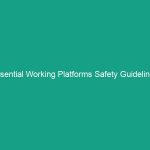Introduction
In today’s fast-paced work Environment, the significance of a robust Health, Safety, and Environment (HSE) policy cannot be overstated. A well-structured Workplace Safety policy development process plays a crucial role in safeguarding employees, ensuring compliance with Regulations, and ultimately fostering a culture of Safety within an organization. This article delves into essential guidelines for effective Workplace Safety policy development, emphasizing the imperative nature of a proactive approach towards health and Safety.
Workplace injuries and illnesses can have devastating Effects, not only on employees but also on organizations as a whole. The financial burden of accidents can lead to increased insurance premiums, loss of productivity, and damage to the company’s reputation. Therefore, understanding the components of effective Workplace Safety policy development is vital for any organization aiming to mitigate risks and create a secure working environment.
This article will explore various facets of Workplace Safety policy development, including regulatory frameworks, best practices, case studies, challenges, and future trends. By integrating these elements, organizations can develop comprehensive policies that not only comply with legal requirements but also prioritize the well-being of their workforce.
Regulatory Frameworks for Workplace Safety
Understanding the regulatory frameworks governing workplace safety is fundamental to effective workplace safety policy development. Legal requirements vary by country and region, but they typically include specific Standards and guidelines that organizations must adhere to.
Key Regulatory Bodies
In the United States, the Occupational Safety and Health Administration (OSHA) is a primary regulatory body overseeing workplace safety. osha sets and enforces standards, provides Training and outreach, and ensures that employers maintain a safe working environment. Similarly, in other countries, governmental organizations such as the Health and Safety Executive (HSE) in the UK or Safe Work Australia implement regulations and guidelines that organizations must follow.
International Standards
Beyond national regulations, international standards such as ISO 45001 provide a framework for Occupational Health and safety management systems. This standard helps organizations identify and manage safety risks, ensuring continuous improvement in workplace safety. By adhering to these internationally recognized standards, organizations can enhance their safety policies and align them with global Best Practices.
Compliance Requirements
Compliance with workplace safety regulations is not merely about avoiding penalties; it is an opportunity to cultivate a safety-first culture. Organizations must regularly conduct risk assessments, maintain accurate records, and ensure that safety training programs are up-to-date. Non-compliance can result in severe consequences, including fines, legal action, and increased liability.
Best Practices for Workplace Safety Policy Development
Effective workplace safety policy development requires a thoughtful approach that incorporates Best Practices from various industries. Implementing these best practices can lead to significant improvements in workplace safety and employee engagement.
Involve Employees in Policy Development
One of the most effective strategies in workplace safety policy development is to involve employees directly in the process. Employees are often the best source of information regarding the Hazards they face daily. Establishing safety committees or focus groups can provide valuable insights and foster a sense of ownership and accountability among staff.
Conduct Regular Training and Drills
Regular training sessions and emergency drills are essential components of workplace safety policy development. Training should cover not only compliance with safety regulations but also practical skills that employees can apply in case of an emergency. By conducting drills, organizations can identify weaknesses in their emergency response plans and make necessary adjustments.
Utilize Technology for Safety Monitoring
Incorporating technology into workplace safety policy development can enhance monitoring and reporting processes. Tools such as incident reporting software, safety management systems, and mobile applications can streamline safety data collection and analysis. This data can then inform decision-making and help organizations identify trends and areas for improvement.
Case Studies in Successful Workplace Safety Policy Development
Nothing illustrates the importance of effective workplace safety policy development better than real-world examples. Here, we explore case studies of organizations that have successfully implemented robust safety policies and the outcomes of their efforts.
Case Study 1: Manufacturing Company
A manufacturing company faced high rates of workplace injuries due to inadequate safety protocols. By conducting a comprehensive review of their safety policies, they identified gaps in training and equipment safety checks. After implementing a new training program and enhancing equipment Maintenance schedules, the company saw a 30% reduction in workplace injuries within the first year.
Case Study 2: Construction Firm
A construction firm recognized the need for improved Safety Measures after a serious accident resulted in injuries to multiple workers. The company took immediate action by revising their safety policy, incorporating feedback from employees, and conducting regular safety audits. Their commitment to safety led to a 50% decrease in accidents over two years, showcasing the effectiveness of proactive safety policy development.
Challenges in Workplace Safety Policy Development
While developing workplace safety policies is crucial, organizations often face various challenges that can hinder their efforts. Understanding these challenges is essential for effective workplace safety policy development.
Resistance to Change
Resistance to change is a common barrier in workplace safety policy development. Employees may be accustomed to certain practices and reluctant to adopt new Safety Measures. To overcome this, organizations should emphasize the Benefits of new policies and actively involve employees in the development process. Communication and education are key to fostering acceptance of change.
Lack of Resources
Many organizations struggle with limited resources, whether financial, human, or technological. Developing and implementing effective safety policies requires investment in training, equipment, and technology. Organizations may need to allocate budgets strategically, seeking external funding or partnerships to enhance their safety initiatives.
Keeping Policies Up-to-Date
Workplace safety regulations and best practices are continually evolving. Organizations must ensure that their safety policies are regularly reviewed and updated to reflect current standards. Establishing a routine for policy review and incorporating feedback from employees can help organizations stay compliant and proactive in their safety efforts.
Future Trends in Workplace Safety Policy Development
The landscape of workplace safety is constantly changing, influenced by advancements in technology, shifts in workplace culture, and emerging safety trends. Organizations must stay abreast of these trends to ensure effective workplace safety policy development.
Increased Focus on Mental Health
As awareness of mental health issues grows, organizations are beginning to incorporate mental well-being into their workplace safety policies. This includes offering resources for stress management, creating supportive environments, and promoting work-life balance. Addressing mental health is crucial for overall employee well-being and can significantly impact productivity and safety.
Embracing Remote Work Safety
The rise of remote work, accelerated by the COVID-19 pandemic, presents new challenges for workplace safety policy development. Organizations must consider how to ensure the safety of employees working from home, including ergonomic assessments and mental health support. Developing guidelines that address remote work safety is essential for maintaining a comprehensive safety policy.
Leveraging Data Analytics
Data analytics is becoming increasingly important in workplace safety. Organizations can leverage data to identify trends, predict potential Hazards, and make informed decisions regarding safety measures. By utilizing data analytics, organizations can enhance their safety policies and create targeted interventions that improve outcomes.
Conclusion
Developing an effective workplace safety policy is a fundamental aspect of fostering a safe and healthy work environment. By understanding regulatory frameworks, implementing best practices, learning from case studies, overcoming challenges, and staying informed about future trends, organizations can create comprehensive safety policies that protect their workforce and enhance productivity.
As we move forward, it is crucial for organizations to prioritize workplace safety policy development as an ongoing process rather than a one-time effort. Engaging employees, utilizing technology, and staying compliant with regulations are all vital components of successful HSE strategies. We encourage all organizations to take proactive steps towards enhancing their workplace safety policies and fostering a culture of safety for the benefit of everyone involved.


